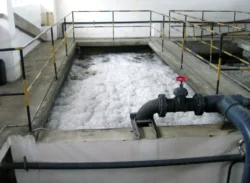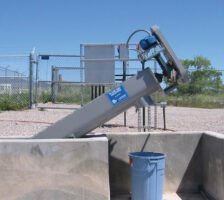
Aeration Basin in Wastewater Treatment: A Comprehensive Guide

In the intricate world of wastewater treatment, the aeration basin is an indispensable component. Essential to the breakdown of organic material and the reduction of contaminants, the aeration basin serves as a controlled environment where aerobic microorganisms thrive. This article aims to provide an exhaustive overview of the aeration basin, examining its design, function, operational considerations, and role in the broader context of wastewater treatment.
Introduction
Wastewater treatment is a multi-stage process designed to remove contaminants and generate effluents suitable for discharge back into the environment or for reuse. One of the critical stages in this process is biological treatment, which relies on microbial activity to degrade organic pollutants. The aeration basin is the heart of this stage, providing the necessary conditions for efficient biological degradation.
The Basics of Aeration Basins
Definition and Purpose
An aeration basin is a tank where air (or oxygen) is diffused into wastewater. The primary purpose of aeration is to maintain aerobic conditions, ensuring that microorganisms responsible for degrading organic matter have the oxygen they need to thrive and perform their function efficiently.
Key Components
-
- Aerators: Devices that introduce air or oxygen into the water. These can be mechanical surface aerators or diffused air systems, where compressed air is forced through diffusers placed at the bottom of the basin.
-
- Mixers: Ensure uniform distribution of dissolved oxygen and maintain the suspension of microbial floc and organic matter.
-
- Aeration Tank: The physical structure, often designed to maximize contact time between the microorganisms and the wastewater, enhancing treatment efficiency.
Types of Aeration Systems
1. Mechanical Aeration
Mechanical aerators introduce air by agitating the surface water. This form typically involves rotating blades or paddles, providing oxygen transfer through surface contact. Common types of mechanical aerators include:
-
- Surface aerators: Positioned at the water surface, creating a large surface area for oxygen transfer.
-
- Turbine aerators: Employ submerged turbines to mix air with water.
2. Diffused Aeration
Diffused aeration systems introduce compressed air through diffusers located at the bottom of the aeration basin. Types include:
-
- Fine bubble diffusers: Produce small bubbles, offering a high surface area for oxygen transfer.
-
- Coarse bubble diffusers: Generate larger bubbles, less efficient but less prone to clogging
Biological Processes in the Aeration Basin
Microorganisms
The central players in the aeration basin are the microorganisms, primarily bacteria, which consume organic matter. Among these, several types are notable:
-
- Heterotrophic bacteria: Utilize organic carbon as a food source.
-
- Nitrifying bacteria: Convert ammonia to nitrate through nitrification, crucial in removing nitrogen from wastewater
Biochemical Reactions
The microorganisms undergo several biological processes, key among them:
-
- Aerobic Respiration: Breakdown of organic matter in the presence of oxygen, releasing carbon dioxide and water.
-
- Nitrification: The two-step conversion of ammonia to nitrate. Ammonia-oxidizing bacteria (AOB) first convert ammonia to nitrite, followed by nitrite-oxidizing bacteria (NOB) converting nitrite to nitrate.
Design Considerations of Aeration Basins
Sizing and Dimensioning
Designing an aeration basin involves careful consideration of several factors to ensure optimal performance:
-
- Hydraulic Retention Time (HRT): The period wastewater spends in the aeration basin, typically ranging from 4 to 8 hours in conventional systems.
-
- Organic Load: Measured as Biochemical Oxygen Demand (BOD), dictates the size and capacity of the aeration basin.
-
- Mixed Liquor Suspended Solids (MLSS): Concentration of suspended solids, including microorganisms, crucial for biodegradation.
Flow Patterns
The flow pattern within an aeration basin affects the interaction between wastewater, microorganisms, and oxygen. Commonly used patterns include:
-
- Plug Flow: Wastewater flows in a straight line from the inlet to the outlet. It is highly efficient but sensitive to shock loads.
-
- Complete Mix: Wastewater is uniformly mixed throughout the basin. It is robust against varying loads but less efficient than plug flow.
Operation and Maintenance
Operational Parameters
Maintaining optimal conditions within the aeration basin requires monitoring and regulating several parameters:
-
- Dissolved Oxygen (DO): Typically maintained between 1-3 mg/L to ensure adequate oxygen supply.
-
- pH Levels: Optimal pH range of 6.5 to 8.5 to support microbial activity.
-
- Temperature: Influences microbial metabolism; ideal range is 20-35°C.
Common Challenges and Solutions
-
- Foaming: Caused by filamentous bacteria or surfactants. Controlled by adjusting operating conditions or adding antifoaming agents.
-
- Sludge Bulking: Occurs when biomass becomes slow-settling. Managed by optimizing nutrient ratios and improving aeration rates.
Advanced Aeration Technologies
Membrane Aerated Biofilm Reactor (MABR)
A cutting-edge technology involving membranes to introduce air directly to biofilms, enhancing oxygen transfer efficiency and reducing energy consumption.
Integrated Fixed Film Activated Sludge (IFAS)
Combines traditional activated sludge with fixed-film media, increasing biomass concentration and treatment efficiency without expanding the basin.
Environmental and Economic Considerations
Energy Consumption
Aeration is the most energy-intensive stage in wastewater treatment, often accounting for 50-60% of total energy use. Therefore, selecting energy-efficient aeration systems and optimizing operations is crucial.
Properly designed and operated aeration basins significantly reduce the environmental impact of wastewater discharge by lowering pollutant levels and mitigating eutrophication in receiving water bodies.
Case Studies
1. Example of Municipal Wastewater Treatment Plant
A large municipal wastewater treatment plant integrates advanced aeration technology with traditional methods to manage varying loads effectively and meet stringent discharge requirements.
2. Industrial Wastewater Treatment
An example of an industrial facility treating high-strength wastewater using aeration basins, highlighting the adaptability and robustness of aerobic treatment processes in diverse contexts.
Future Directions
The future of aeration basins lies in continuous improvement through innovation and technology integration:
-
- Automation and Control: Implementing advanced monitoring and control systems to optimize aeration efficiency and reduce operational costs.
-
- Energy Recovery: Exploring options for energy recovery from the wastewater treatment process to enhance sustainability.
Conclusion
The aeration basin is a pivotal component of wastewater treatment, playing a crucial role in the biological degradation of pollutants. Understanding its design, operation, and the biological processes within it provides a foundation for optimizing performance and ensuring effective treatment outcomes. Advances in technology and operational strategies continue to enhance the efficiency and sustainability of aeration basins, positioning them as integral to the future of wastewater treatment.


